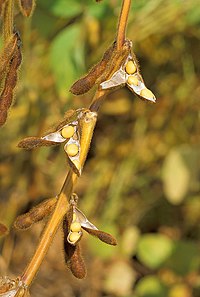
Photo from wikipedia
Soybean (Glycine max L.) is an important crop in China owing to its high oil and protein content, with approximately 9.88 million ha of production in 2020. In September 2021,… Click to show full abstract
Soybean (Glycine max L.) is an important crop in China owing to its high oil and protein content, with approximately 9.88 million ha of production in 2020. In September 2021, soybean plants showing wilting, root necrosis, and brown discoloration were observed, with an average incidence of approximately 36% in seven fields in Yongcheng City and Shangqiu City, Henan, China. Fungi were isolated from small pieces of symptomatic root tissues after being surface-sterilized (70% ethanol for 50 s followed by 3% NaClO for 1.0 min), rinsed three times in sterile distilled water, and then placed on PDA and incubated at 25℃ for 5 days in the dark. Single-spore cultures of twenty isolates were obtained by dilution plating (Leslie and Summerell 2006), and then were cultured on carnation leaf agar at 25℃ for 14 days. Macroconidia were mostly 3-septate, hyaline, falcate, with slightly curved apexes, with well-developed foot cells and blunt apical cells, and measured 29.3 to 45.0 (average 34.7) μm × 4.6 to 8.0 (average 6.0) μm. Microconidia were one to two celled, hyaline, and measured 11.9 to 29.0 (average 20.1) μm × 3.9 to 7.6 (average 5.7) μm. These morphological characteristics were consistent with previous descriptions of the Fusarium solani species complex (FSSC) (Leslie and Summerell 2006; Summerell et al. 2003). Partial sequences of translation elongation factor-1α (TEF) and RNA polymerase II subunit (RPB2) gene were PCR amplified using region specific primers as described by O'Donnell et al. (2008). The nucleotide sequences obtained from twenty isolates were deposited in GenBank with accession numbers of ON375405-ON375423, ON697187 (TEF) and ON331917-ON331936 (RPB2). Phylogenetic analysis revealed the isolates were nested within F. falciforme based on the DNA sequences of the above two genes (Chitrampalam and Nelson 2016). Pathogenicity tests of two representative isolates (21BeanYC3-3 and 21BeanYC7-5) were performed on two-week-old healthy soybean seedlings (cv. Shengdou 101) by injecting and cutting root method with a conidial suspension (1×106 conidia per mL) of F. falciforme (2 mL to one seedling). Control seedlings were inoculated with 2 mL distilled water. After 40 days under 25℃, 16h light/8h dark, the root system of all inoculated soybean plants exhibited dark brown lesions over the entire taproot, while control plants remained healthy. The fungus was reisolated from inoculated plants and identified as F. falciforme based on morphological characteristics and molecular methods described above. To our knowledge, this is the first report of root rot in soybean (Glycine max L.) caused by F. falciforme in Henan, China. The results are important for soybean production and breeding programs.
Journal Title: Plant disease
Year Published: 2022
Link to full text (if available)
Share on Social Media: Sign Up to like & get
recommendations!